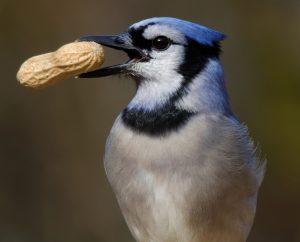 Many people who love feeding birds dislike Blue Jays, because they can be loud and aggressive. Although this is true, there’s so much to love about these intelligent and charismatic creatures!
Many people who love feeding birds dislike Blue Jays, because they can be loud and aggressive. Although this is true, there’s so much to love about these intelligent and charismatic creatures!
Jays are in the Corvid family, which includes ravens and crows. They are very intelligent, capable of problem solving and mimicking the calls of some other bird species. Blue Jays mimic Red-tailed and Red-shouldered Hawks extremely well. This may be to alert other jays about the presence of these hawks, but they sometimes use it to their advantage at feeders by using hawk calls to scare other birds away from feeders, giving them open access to the food. This advantage can be short-lived, as the other birds are quick to return to the feeder when they realize that there’s no hawk in the area.
Adult males and females look very similar, although females are a bit smaller. Juveniles tend to have proportionately more grey than blue. During the breeding season (spring & summer), males often follow their mate around in a behaviour known as “mate guarding.” Blue Jays maintain close family ties and often mate for life. About 20% of jays migrate south in large groups for the winter, but the majority remain in their breeding area over the winter.
“Blue” Jays
Most people would describe Blue Jays as… well… blue (which is supported by their name!), but everything that looks blue on them is actually brown! The reds, oranges, and yellows that we see in birds come from pigments in the feathers, which are typically derived from the food eaten. There are no blue pigments, however, and the blue feathers in Blue Jays are pigmented with melanin, which is brown. Their blue colour we see comes from the way light is reflected by the physical structure of the feathers!
Feeding Jays
Blue Jays’ primary food in the wild is acorns, which they gather and cache by the thousand for future eating. They also eat insects and small dead animals, with about 5% of their diet being eggs and nestlings of other birds. Acorn production varies from year to year and was low this year, so you may find plenty of jays hanging around your feeder this winter.
If you want to help them out, they love peanuts (hulled or in-shell) and suet. They do well at large, platform and hopper-style feeders and have a hard time with small and hanging feeders. Of course, we carry a selection of feeders and seed to support these fascinating birds and would be happy to help you get set up.
